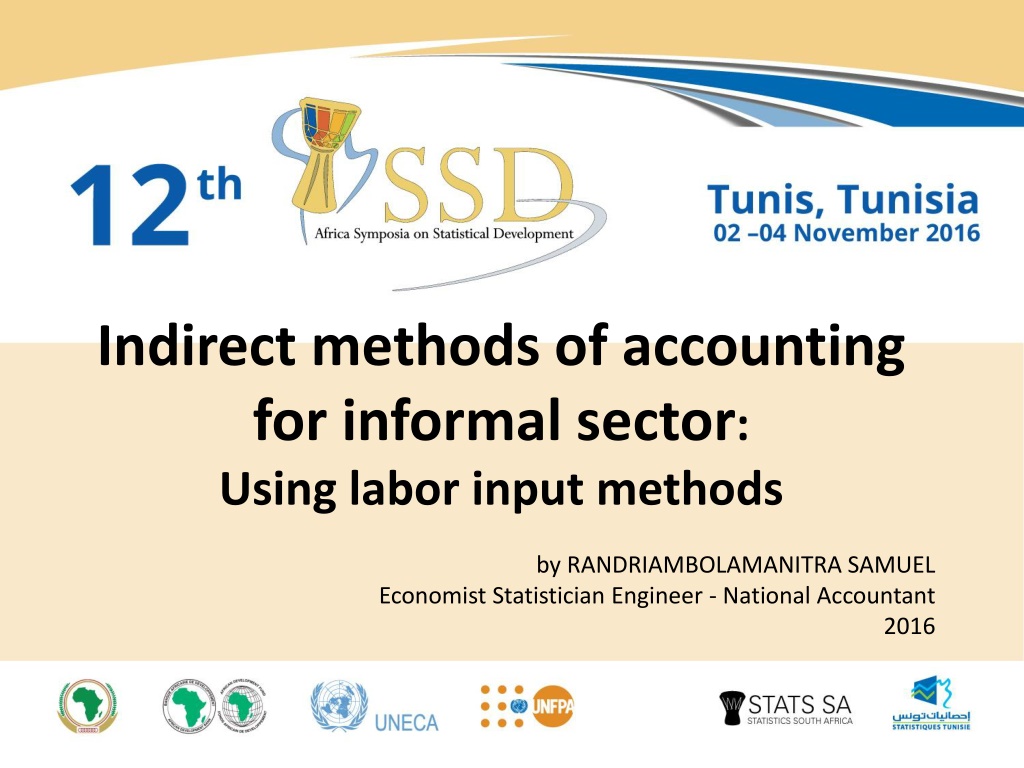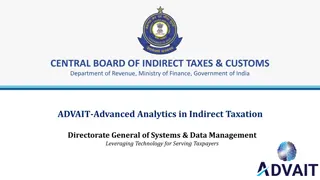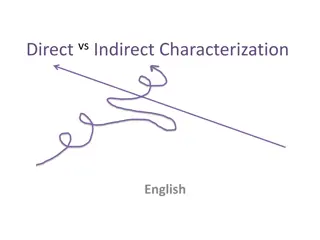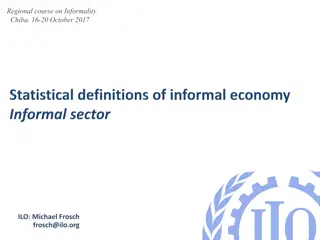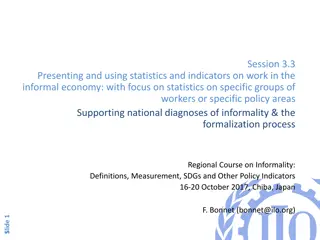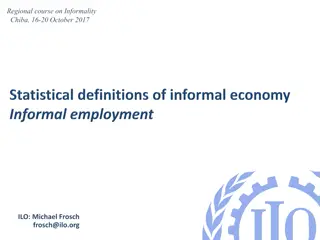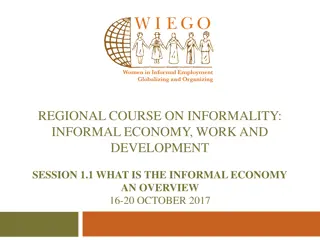Understanding Indirect Methods of Accounting for the Informal Sector
The presentation discusses the significance of the informal sector in the Malagasy economy, its role in providing goods and services, and how it cushions economic shocks. The paper's objectives include valuing the economy, estimating informal sector accounts, and formal and informal employment. Definitions and hypotheses related to informal sector productivity and employment are outlined, along with data sources such as national surveys and demographic census data.
Download Presentation

Please find below an Image/Link to download the presentation.
The content on the website is provided AS IS for your information and personal use only. It may not be sold, licensed, or shared on other websites without obtaining consent from the author. Download presentation by click this link. If you encounter any issues during the download, it is possible that the publisher has removed the file from their server.
E N D
Presentation Transcript
Indirect methods of accounting for informal sector: Using labor input methods by RANDRIAMBOLAMANITRA SAMUEL Economist Statistician Engineer - National Accountant 2016
PRESENTATION STRUCTURE Introduction Paper objectives Definitions, Hypothesis Data sources Your key findings Model Implementation process Challenges, opportunities and perspectives Conclusion 2
INTRODUCTION As everywhere in the world, the informal sector has a significant role in the Malagasy economy, not only in the contribution to the GDP but also in the creation of employments. The informal sector can play the role of support for the formal sector by providing goods or services, for example most of bricks and sands used in the construction sector are provided by the informal sector. The informal sector also plays a kind of mattress which cushioned the shock on the economy. In fact, to each time Madagascar has passed through the economic crisis, more the big formal companies closed more the informal sector developed. In consideration of the fact that there is no unemployment benefit in Madagascar, the majority of the people having lost their employment in the formal sector find recourse in the informal sector by creating its own informal enterprise. Then the unemployment rate (ILO definition) of Madagascar is very lower: 1,3%.
PAPER OBJECTIVES The main objective of this methodology is to cover the valuation of the economy in all, The secondary objectives: The informal sector accounts estimation per each activity, Formal and informal employment estimation per each activity
DEFINITIONS, HYPOTHESIS According to the Survey 123 Informal sector is the manufacturing units devoid of statistical card and/or do not keep written official accountability For this paper Informal employment is the employment non declared to the Caisse Nationale de Pr voyance Sociale (CNaPS). For this paper, we supposed that the employment productivity of the informal sector is the same for some years. Then, each year the production can be calculated by the formula: Production = productivity x employment
DATA SOURCES Survey type 1-2: National coverage Last reference period: 2012 Caisse Nationale de Pr voyance Sociale (CNaPS): Publicly-owned establishment related to commercial industrial placed under the supervision of two Ministries: Ministry in charge of Work and Social Laws, and Ministry in charge of Finances and Budget. Mission: contributing to the achievement of the policy of social protection of the State in favor of the workers of the private sector. Public Administration: Central and local Manage of civil servant Demographic census, estimation (INSTAT) Population numbers Demographic characteristics
KEY FINDINGS This approach allows the: Avalaibility of the annual growth of Informal employment by activity. Avalaibility of production account and operation statement of the informal sector by activity.
MODEL Administration data Social security data Demographic census, estimates Informal sector
MODEL (Cont) Total Employment : TE = Occuped active population + secondary employment Formal Sector (private and public administration) Declared workers numbers of CNaPS: EC=Eff_CNaPS Civil servant numbers: EA=Eff_Adm Informal employment in the formal sector: IEFS Then the informal employment for informal sector IEIS: IEIS=TE-EC-EA-IEFS
MODEL (Cont) Sector informal Production account and Operation statement For bases account: For production calculation, per each activity, only the productivity per employment and the informal sector employment are utilized For rebasement account: We supposed that, per each activity, the informal sector volume growth is equal to the informal employment growth
PROCESSING LABOR MATRIX: Formal sector total estimation SI Houshold sector Houshold sector Informal Sector Total Administration Prived Private Others Activitie Employ- Informal Empl others Sector Total Civil servants number Eff_CNaPS ment declared CNaPS Total_ Workers employ Non_formal workers Non_formal _employ sector Employ Total Informal employ A B B C D C C =D-A-B-B -C = = Pop * total workers Proportional by total formal private sector employment Pop_active_ rate * (1-unemploymt rate) employment + Secondaries
PROCESSING LABOR MATRIX: activity estimation Houshold sector SI Formal sector Total Houshold sector Informal Sector Administration Others Prived Private Activity Total Employ- ment Employ Empl Others sector Total_ Informal employ Civil servants number Total_ Workers employ Non_formal workers Non_formal _empl_ informal sector Eff_CNaPS declared CNaPS Br1 Br2 Br3 Br n-1 Br n Total Empl others sector Informal Sector employ Total employ Civil servants number Informal employ CNaPS
PROCESSING LABOR MATRIX: activity estimation Formal sector Household Sector IS Total Informal Sector Administration Private Others Branche Br1 Data available: Source survey Data available: Source CNaPS Estimated by RAS method Struture available: survey Data available: Source Br2 Administration Br3 type 1-2 type 1-2 Br n-1 Br n Informal Sector empl Empl Others sector Civil servants number Informal empl Total empl Total CNaPS
LABOUR MATRIX RESULTS Formal Sector Household Sector Activities Administration Total Employments Formal Employment Informal Employment Informal Employment Non Informal Employment 1 915 995 56 666 101 772 234 537 12 207 143 153 - 112 925 748 804 148 889 - 63 212 27 762 216 218 - 3 782 141 Primary Extractive Food Confection Wood Other Industries Energy Construction Trade Transport Household Education Health Other Services Public Administration TOTAL 78 917 14 898 30 216 67 985 3 209 37 635 7 207 32 733 64 625 12 002 7 360 38 881 17 058 95 524 - 508 250 5 245 - - 490 - - 320 236 3 993 1 771 - 9 460 704 331 - 22 550 - - - - - - - - - - - - - - - - - - - - - 2 000 157 71 564 131 988 303 012 15 416 180 788 7 527 145 894 817 422 162 662 241 978 245 505 61 897 312 073 124 650 4 822 532 234 618 133 951 16 373 - - - - - 124 650 274 974 234 618
INTEGRATION IN NATIONAL ACCOUNTS Labour productivity Labour matrix Informal sector accounts
INTEGRATION IN NATIONAL ACCOUNTS IS Remu nerati on Production per employ Production = A * Value Added Informal Sector Intermediate GOIM R Technical coefficient consumption Taxes Production Activity available: Source survey type Br1 VA Remuneration-Taxes (Remuneration/ employement) remuneration=A * (production/employment) IC= Prodution * Technical coefficient Employment data available available: Source survey C=B*c Br2 (Taxes/employement) Labour productivity Labour productivity VA=Production - IC Br3 Taxes=A * GIO/MR= type 1-2 1-2 Br n-1 Br n E=A*e D=B-C B=A*b F=A*f G=D-E-F Total b A c
INTEGRATION IN NATIONAL ACCOUNTS Mains data for national accounts Informal sector
INFORMAL SECTOR ACCOUNTS RESULTS Production Value added 2 792 1 793 42 39 321 128 206 127 18 10 Other Industries 176 107 Energy - Construction 224 203 Trade 2 490 1 635 Transport 630 438 Household 159 144 Education 224 112 Health 98 Other Services 766 384 TOTAL 8 148 5 169 Activities Primary Extractive Food Confection Wood salaries Taxes EBE 326 104 1 363 36 119 122 3 8 4 1 0 1 1 0 1 9 10 - 40 57 36 96 - 163 1 541 393 143 97 43 332 4 454 - - 0 38 9 0 2 1 8 165 1 13 6 45 550 49
CHALLENGES, OPPORTUNITIES, PERSPECTIVES To avoid the double accounts or non account anywhere Effects mesure of the shock on the economy: the employment created by the informal sector is decreased if the growth of employment created by the formal sector is more than demographic growth, or the opposite. For the futur, instead of utilizing employment number we use activity duration (hours or Full-time equivalent).
CONCLUSION The informal sector is explained by: the dynamism of the formal sector (private sector and public administration), the demographical behavior of the population, the structural behavior of the informal sector, The calculation of the informal sector account can be done each year, if the data of informal sector and population are available for this period, The informal sector account prevision can be applied, if the data of informal sector and population previsions are available, This approach can be used between two informal sector surveys.
THANK YOU MERCI MISAOTRA
